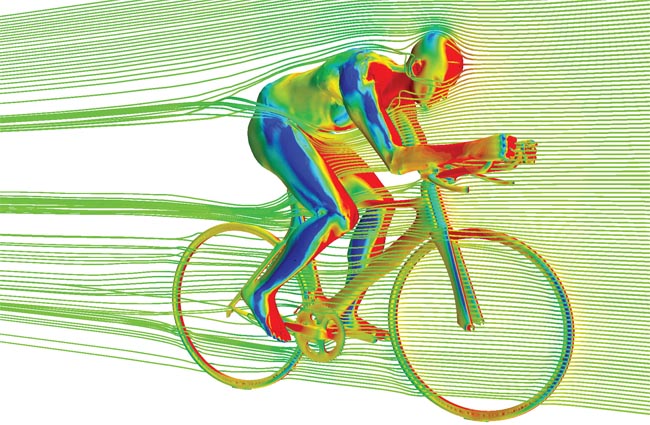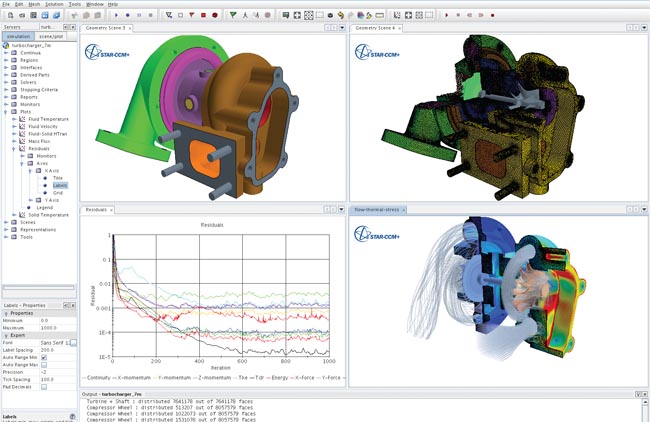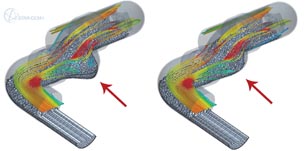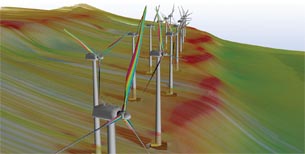Scalable CFD for All: STAR-CCM+ v 4.06
CAD-integrated or independent, STAR-CCM+ is suitable for analysis and visualization users at all levels in all industries.
Latest News
April 1, 2010
By Vince Adams
STAR-CCM+, the flagship product from CD-adapco and currently in v4.06, builds on a strong leadership position in advanced computational fluid dynamics (CFD) for both analysis professionals and design engineers who need fast insight without the burden of detailed modeling tasks.
 Pressure fringe plots and streamlines simulating a racing bicycle in a wind tunnel. Image courtesy of Felt Bicycles |
Developers have created an associative and embedded CAD interface to Pro/ENGINEER, SolidWorks, CATIA, and NX so engineers can optimize flow-related performance at the earliest conceptual stages of a design. STAR-CCM+ also comes in a CAD-independent product that provides the same geometry-based ease-of-use with import from many native CAD formats, all standard geometry neutral formats, and commonly available finite element mesh (FEM) neutral formats. This, combined with a familiar-feeling, feature-tree based user interface, makes STAR-CCM+ suitable for all sorts of users.
Skeleton Files
A powerful feature of STAR-CCM+ that enables knowledge capture and sharing within an organization is the implementation of Skeleton Files. Skeleton Files are essentially templates that contain all the property, boundary condition, and CFD-specific input for a given type of problem. Skeleton Files can be used at all levels as just one of the many automation tools to increase productivity. Skeleton Files can also be created by CFD specialists to capture all the important setup information, results displays, and reports needed to evaluate iterations. All a design engineer needs to do is import geometry and update part names. The rest can be automated.
 The STAR-CCM+ interface shows tiled graphics windows in addition to the feature tree and properties alongside, and the log below the windows. |
Geometry & Interchangeability
The STAR-CCM+ workflow is optimized for CFD model development. From within a pre-defined Skeleton File or in a project developed from scratch, users can complete a baseline study with inlets, outlets, and boundary conditions defined. Then a part or group of parts can be swapped and the solution re-run with minimal effort. Three features in STAR-CCM+ greatly facilitate this. The first is that properties or boundaries are associated to part or body names. When a part is replaced and assigned the proper tag, STAR-CCM+ immediately recognizes its proper place in the model setup. This greatly improves efficiency and “time to insight” over traditional CAD-based interfaces requiring body or face selection and re-assignment.
The second feature that is unique to STAR-CCM+ is the ability to estimate initial conditions in the replaced part by extrapolating the converged results from the previous solution to the new geometry. CFD relies on iterative calculations converging to a final solution. As with any iterative process, the closer the starting conditions are to the final solution, the faster convergence is achieved. Each design iteration in STAR-CCM+ solves much faster than a solution from scratch.
Meshing
The third feature in STAR-CCM+ that enables fast and intuitive design iterations is called surface wrapping. Surface wrapping creates a clean closed surface from discontinuous CAD geometry. This technology can automatically build a CFD-optimized triangular surface mesh around the most complex assembly, which then serves as the basis for the rest of an automated mesh—often the biggest hurdle to efficiently integrating CFD in the design process. For more traditional analysts, this process still allows for intervention so that meshing parameters and surface closure can be tweaked, but that’s the beauty of STAR-CCM+. The program can be used at any level necessary.
 The complex connector was changed after the initial solution in STAR-CCM+ to improve flow results with no manual re-meshing and minimal effort to re-solve. |
There are even more important features of STAR-CCM+ that facilitate meshing. One is the use of dynamically sized control volumes for mesh refinement. While local, geometry-based mesh refinement is an option, mesh control within the flow field can be as important as on the surface. A rectangular mesh control volume around a flow system can ensure a good mesh everywhere the results are important. Another important feature in the automatic mesher is the ability to create body-fitted prism cells at the critical boundary-layer transition areas. Unlike tetrahedra in the rest of the flow field, more regular shaped elements in the boundary layers will converge more quickly and capture more accurate results.
User Interface
STAR-CCM+ developed an intuitive multiwindow, feature-tree based interface years ago that is now popular among other geometry-focused tools. A feature tree window allows parts, properties, input data, and other modeling entities to be dragged and dropped within a single model or across multiple open models. When any feature in the tree is selected, a Property Window displays all the relevant properties of that feature for easy review and modification. The Graphics or Working Window can support multiple open models with a tabbed structure.
Finally, for the more traditional user, a Log Window echoes keystrokes, inputs, and messages. Many design users will simply turn this off to create more viewing space but power users will welcome the feedback. This log also forms the basis of a powerful record-and-play scripting capability to further automate repetitive tasks.
Postprocessing
STAR-CCM+ provides results feedback to the user after each converged iteration. This important feature lets users catch setup errors or inappropriate model response before the solution completes. Once a valid solution is completes, STAR-CCM+ has a full suite of results-processing tools to ensure an in-depth understanding of system performance. These include 2D graphs, fringe, and streamline plots. One interesting plot is a reverse streamline. In a typical streamline plot, nodes at an inlet are selected and their travel through the flow stream is mapped. This can be hit-or-miss for adequate streamline coverage at all outlets. STAR-CCM+ allows you to select outlets of importance instead and the upstream paths are identified.
 Flow-induced pressure fringe plots on wind turbine blades with streamlines of the environmental airflow superimposed. |
An important reporting tool offered by STAR-CCM+ is Scene Files. Much like Active Pictures in LMS Test.Lab or eDrawings from SolidWorks, Scene Files of results can be embedded in PowerPoint or other MS applications. A Scene Files Viewer can also be downloaded from CD-adapco to enable results viewing on any PC even without embedded data.
Power-User Capabilities
Seasoned CFD users should appreciate the ease-of-use enhancements of STAR-CCM+ but it doesn’t end there for power users. Breaking free from the common licensing structure for high-end analysis tools, a STAR-CCM+ license contains all the features that are available in the product versus having to purchase individual line items.
The list of high-end features covers nearly everything a CFD specialist needs. These include transient and unsteady Implicit/Explicit events; fluid-structure coupling with moving parts in the flow stream and moving reference frames; small displacement stress calculations from flow pressures or thermal effects so CFD-Stress iterations are no longer required; multiphase conditions including free surface, boiling, cavitation, and Lagrangian; porous media, fan, and heat exchanger models; and heat transfer with conduction, convection, solar, and thermal radiation.
STAR-CCM+ is fast on a typical workstation or laptop but when model size or transient-run resolution becomes great, the software can easily be run on multiple cores, CPUs, or in a computing cluster. STAR-CCM+ does require additional licenses for multiple CPU solutions but offers a Power Session license allowing unlimited CPU or core usage for even more solution flexibility. This is most cost-effective when runs requiring eight or more CPUs are regular occurrences.
CFD is the fastest growing CAE domain, but integration of this technology into the design phase is still a challenge. STAR-CCM+ offers a powerful and unique solution to the integration of both high-end and design-level CFD and should be considered by any company hoping to grow this skill set in their product development process.
And beyond the technology is a STAR-CCM+ team committed to making their customers successful. As some customers have pointed out, the greatest advantage to STAR-CCM+ is the support.
CD-adapco assigns a support engineer to each one of its customers. The report engineer is charged with learning the customer’s challenges and acts as a consulting CFD expert to the staff. The service is part of the standard maintenance charge and is seen—by both CD-adapco and its customers—as critical to a lean engineering team.
More Info:
CD-adapco
Vince Adams is DE’s expert in simulation, having worked and taught in the field for 20 years. He is the co-author of three books and numerous articles on FEA and design analysis. Comments should be sent to [email protected].
Subscribe to our FREE magazine, FREE email newsletters or both!
Latest News
About the Author
DE’s editors contribute news and new product announcements to Digital Engineering.
Press releases may be sent to them via [email protected].






